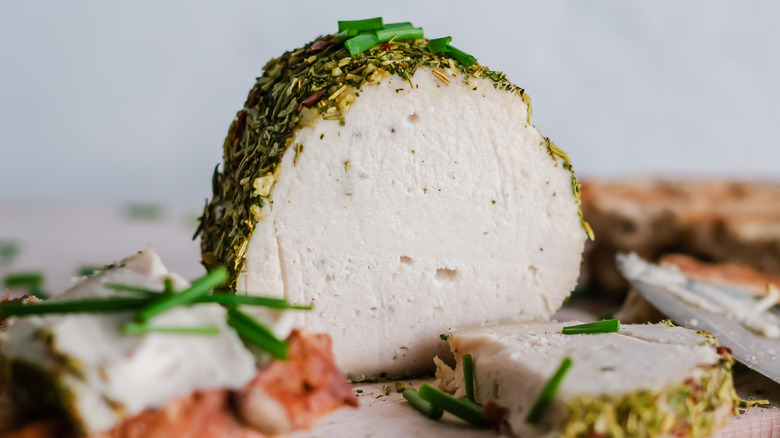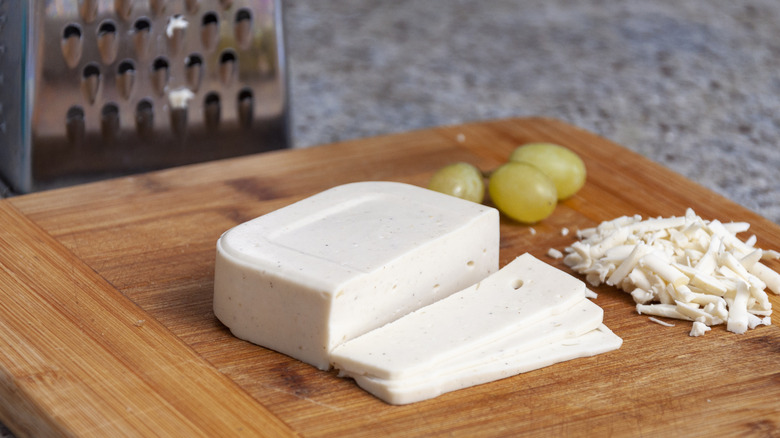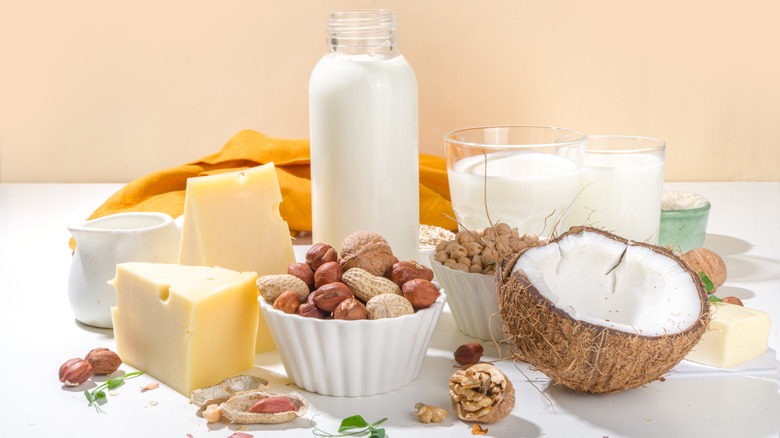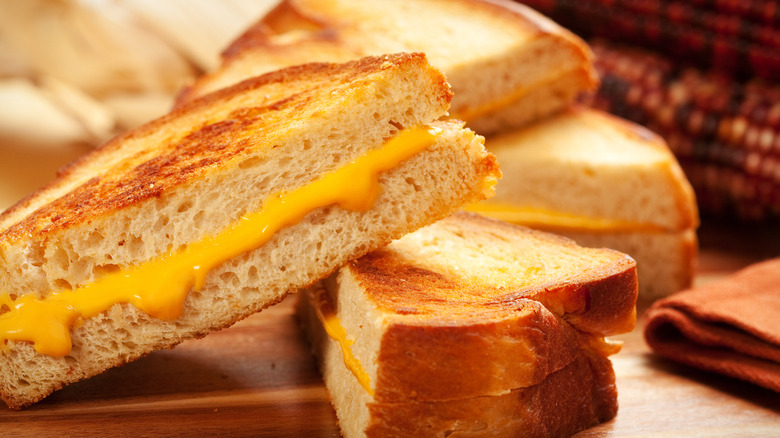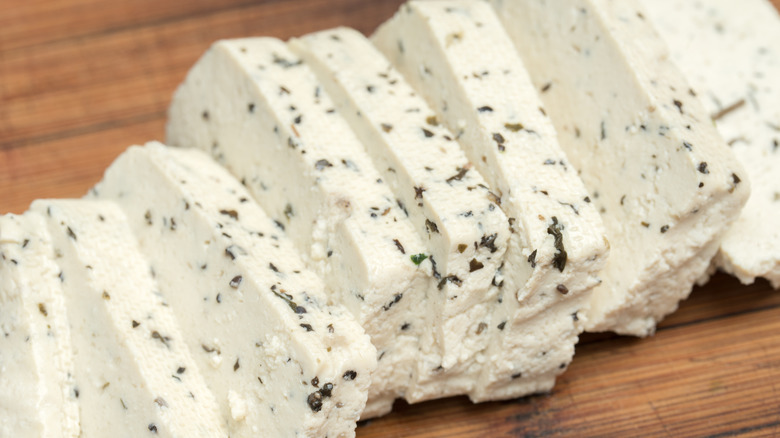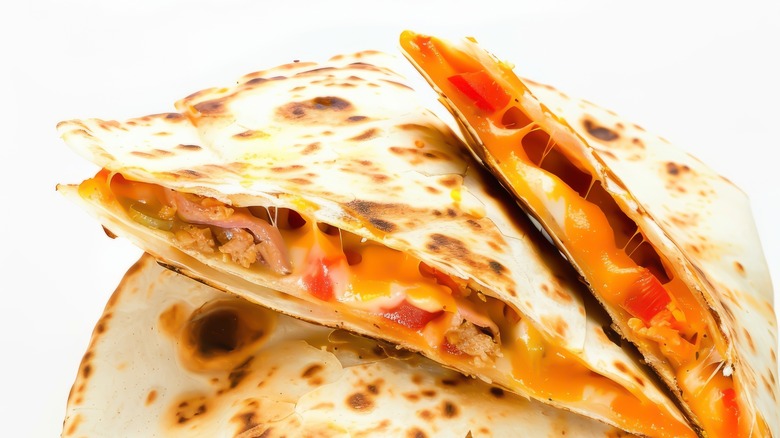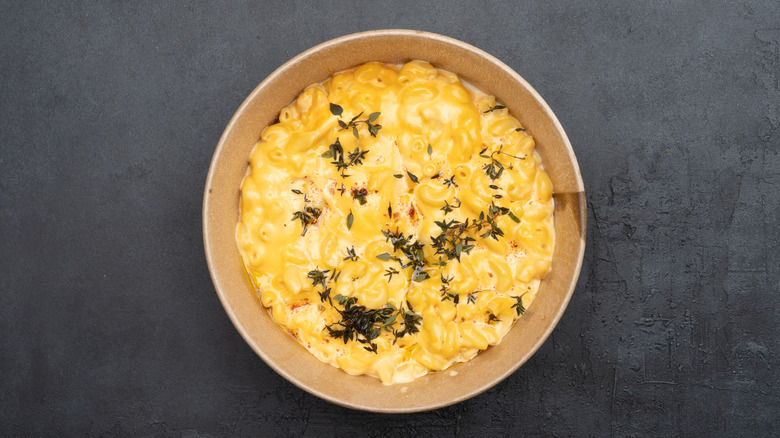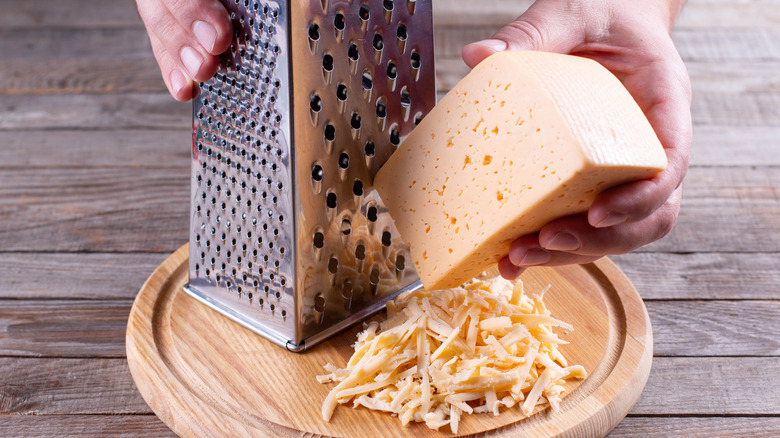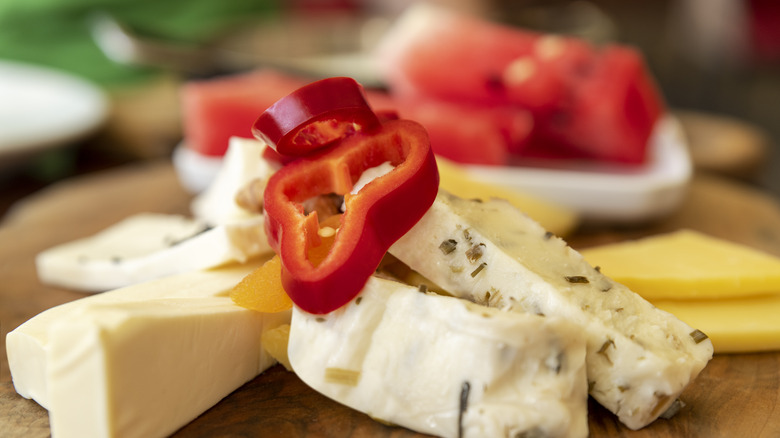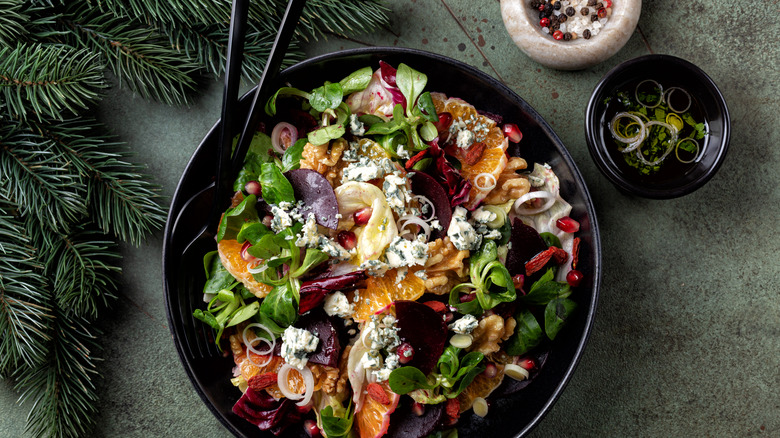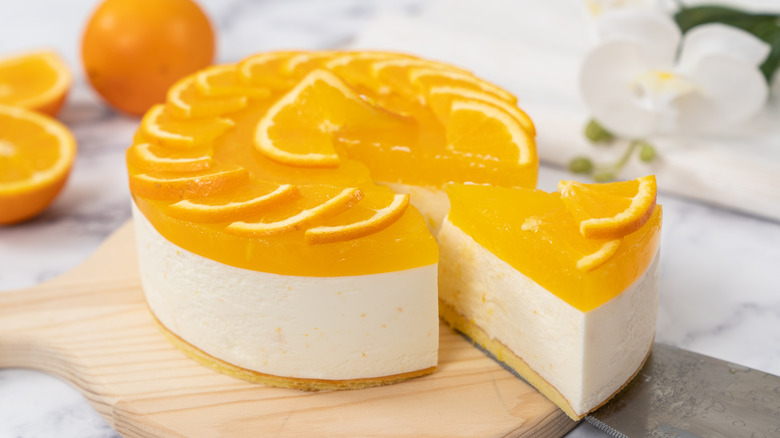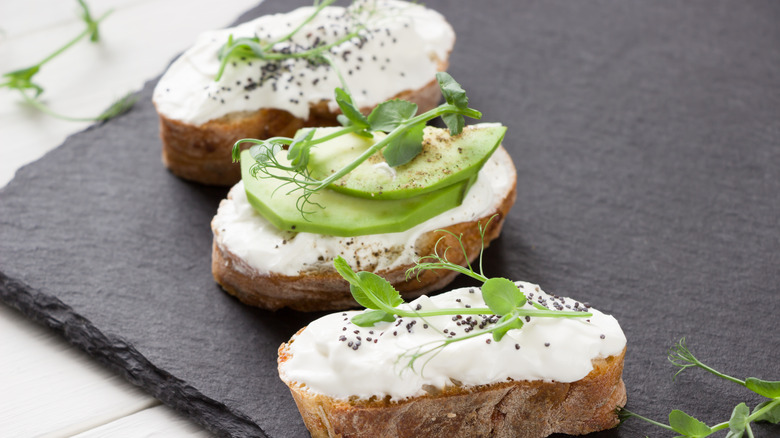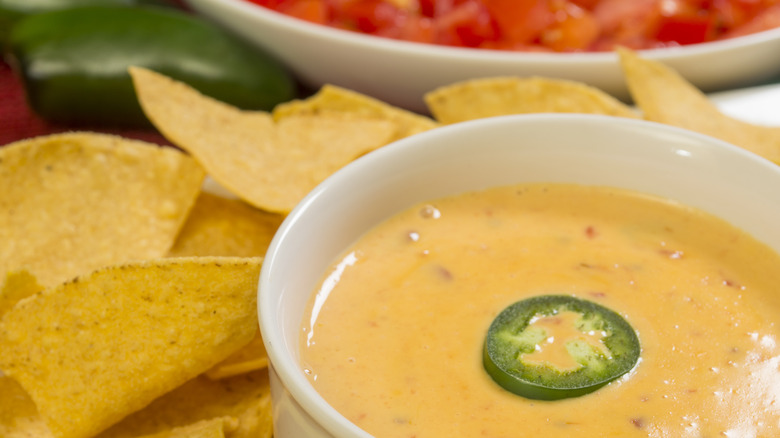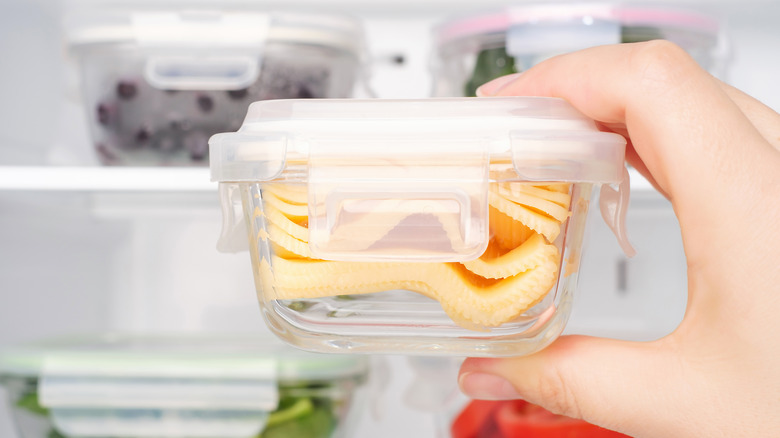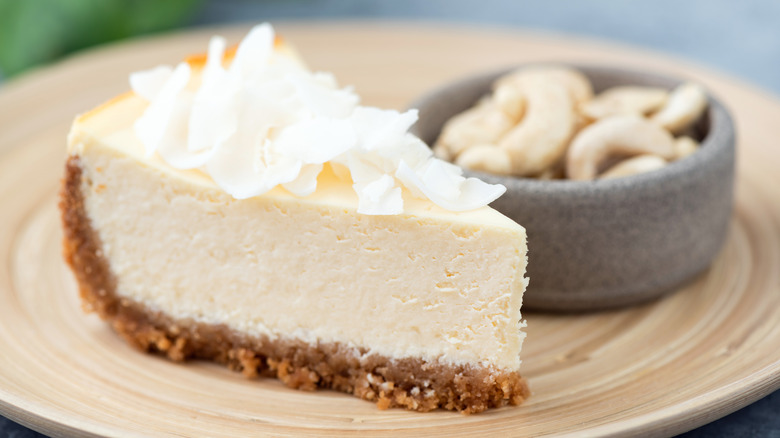The Dos And Don'ts Of Using Vegan Cheese
Vegan cheese is an ingredient that many of us would like to understand better but may not have all the information. If you're one of those people, who can blame you? These gluey hunks of non-animal protein are available at the store, but rarely come with a user's manual.
What makes it more complicated is the fact that if you buy vegan cheese off the shelf and try to do different things with it sans proper recipes, it's usually a failure. It melts differently, blends into sauces differently, and can taste very strange if you do the wrong thing.
To ensure the best possible advice, Chowhound spoke with food blogger Rena Awada and Executive Chef Nic Vanderbeeken to learn of the best ways to source, cook and use vegan cheese. So the next time you're standing in front of the cold case staring at the non-dairy crew, you'll be better informed.
A brief history of vegan cheese
Non-dairy cheese, otherwise known as vegan cheese, is made to mimic products made from animal milks without using animal ingredients. Some historians say that tofu was the first kind of cheese due to its similar consistency and the fact that it is fermented. Originally, this "cheese" contained traditional tofu ingredients such as soybeans, salt, vinegar, oil, and rice wine. Later, in the late 1800s, it was nicknamed "fromage de soja", which translates to "soy cheese."
In 1910, Li Yu-ying, an early pioneer of tofu, created some of the first non-dairy cheeses, including Gruyere, Roquefort, and Camembert. As for who lit a new fire under the consumption of modern non-dairy cheese, some attribute that honor to Miyoko Schinner, founder of Miyoko's Creamery, which makes vegan cheeses and butters. Schinner was determined to reinvigorate the dairy-free cheese scene. Since 2014, when she launched her business selling wholesale, vegan cheese, it has become de rigeur in many households.
How non-dairy cheese is made
Vegan cheese is made from a wide variety of non-dairy ingredients. Tofu and other soy products often form the base of vegan cheese, as do nuts and nut milks. Pecans, almonds, cashews, macadamia nuts, and sunflower and pumpkin seeds are all common ingredients. So is coconut milk, perfect for its high fat content just like nuts (and actual dairy). Tapioca is a thickener you'll often find in non-dairy cheese as well.
The process of making vegan cheese is much like that of any other cheese. A bacterial culture separates the proteins from the liquid and causes them to clump. These curds, when pressed together, form the cheese. However, non-dairy cheese lacks some important properties, so manufacturers add other products, such as oils, emulsifiers, and flavorings, to help it achieve a cheese-like texture.
Because of these added ingredients, vegan cheese is more highly processed than traditional cheese, whose ingredients are usually limited to milk; different bacterial cultures that determine the type of cheese, rennet to cause separation, and salt. For that reason, it is closer to American cheese than "real" cheese, but still tastes lovely if you use it right.
Common varieties of vegan cheese
There are a variety of vegan cheese brands to choose from, including vegan brands. You can find simulacra of cheddar, mozzarella, Gouda, Parmesan, and Swiss. Soft cheese options include cream cheese, Brie, Camembert, blue cheese, and ricotta. You can also buy it whole, sliced, shredded, crumbled, or already made into sauce. This makes it easy to match your type of cheese to the recipe you're using. Factors such as whether the dish is hot or cold, whether cheese is the star or a helper ingredient, or the season can all influence the best type to use.
Most upscale grocery stores have a good selection of vegan cheeses at this point, and you can usually find at least a few varieties at any good-sized neighborhood store. If those aren't available in your area, you can find anything you like online. Make sure to look up the brand you're considering ahead of time, as some, Go Veggie vegan cheese, may not have the best reputations.
How to use vegan cheese in the kitchen
Vegan cheese is amenable to many types of recipes. It is actually quite flexible, as long as you know what you're doing. It works in everything from soups to quiches, breads to salads, cream pies to brownies. Depending on the type of cheese and how you cook it, it will melt into quesadillas, grilled cheese sandwiches, and nachos. Once you look into it, you'll be surprised how flexible it really is, as long as you know what you're doing.
It's also simple to make vegan cheese at home using a variety of easy-to-find ingredients, and if you want to make your own, there are a variety of vegan and non-vegan blogs around filled with recipes. The recipes do get a little creative (such as using little tubes to create the holes that naturally arise in Swiss cheese), but they're often quite good. Here are some do's and don'ts to pay attention to the next time you make a batch.
Do: check your ingredients
"If you want to use vegan cheese, the very first thing to consider is the ingredients," says Awada, creator of Healthy Fitness Meals, a popular food blog. "Vegan cheese can be made from a variety of plant-based options. To ensure you are getting the best quality and taste, make sure to read the ingredients list carefully." She recommends looking for brands that rely on whole foods in their ingredients, steering clear of additives or preservatives.
Vanderbeeken, executive chef at Apéritif Restaurant in Ubud in Bali, agrees that ingredients really do matter. "Vegan cheese is a crucial component in many of my dishes," he says, adding that you should also pay attention to the texture. "Some brands excel at creating cheese that melts well, while others are better for slicing and serving cold," he notes. Vanderbeeken suggests reading brand reviews and look for ones with "a good reputation" to help guide you toward selecting good ingredients.
Don't: expect vegan cheese to melt at the same point way
Sadly, vegan cheese doesn't melt the same as regular cheese because it lacks a critical ingredient: casein. This protein is what gives cheese its normal meltability and stretch, like you would associate with biting into a good grilled cheese or slice of pizza. Unfortunately, it's an ingredient that only comes from mammals' milk.
Often vegan cheese will even look melted when it isn't, and you can't tell until you bite into it. That's why many people opt to make it into sauce before applying it to nachos. If you simply plop vegan cheese shreds onto hot meat or beans, it will taste gross and waxy, so don't do it.
Fat is also an issue, says Rena Awada. Because of this, she recommends a plant-based milk, such as coconut oil, to the cheese while you're trying to melt it. "This will give it a creamier texture and help it melt more evenly," says Awada.
Do: cook low and slow for melting
Quick steps such as broiling cheese, tossing a slice on a burger at the end of cooking, or throwing shreds into an omelette are all ways we're used to melting dairy-based cheese, and they work great. However, melting vegan cheese can be a challenge. Because of that, Nic Vanderbeeken advises, "It's important to melt vegan cheese slowly over low heat to prevent it from becoming gummy or separating."
With grilled cheese sandwiches and quesadillas, turn the heat down to prevent the bread or tortilla from scorching before the insides melt. If you're cooking it in a pot, add a little bit of plant-based milk to start, then add more if needed. Be cautious, or your sauce will lose its thickness and velvety texture. Nonstick pots and silicon spatulas can help avoid sticking and burning too.
Despite this trick, Rena Awada cautions that the cheese still may not melt as well and can easily burn. "So it's best to try out different brands and find the one that works best for your desired texture," says Awada. "Also, make sure to monitor the cheese closely and remove it from heat once it reaches your desired consistency."
Don't: try to melt huge slabs of cheese
You'll get further with vegan cheese if you don't try to melt huge slabs, which is never very effective. Instead, grate your cheese before applying it to pizzas or grilled cheese. The finer the shreds, the more melted they'll get. You can even mix it with other ingredients, such as water or mayo to aid in creating a cheesy melty effect, but make sure you follow a recipe while you're doing it. Nic Vanderbeeken advises looking for vegan cheese that is specifically designed to melt effectively.
"I prefer using vegan cheeses specifically labeled as 'melting' or 'shreddable' for recipes that require a good melt, like pizzas and grilled cheese sandwiches," he says. Chao Creamery Plant-Based Shreds, Daiya Dairy-Free Mozzarella Shreds and Miyoko's Pourable Plant Milk Mozzarella are just some examples of vegan cheeses that were designed to melt well, perfect for your next pizza night.
Do: use different cheeses for hot dishes and cold sandwiches
Because of texture and consistency, you'll want to select your cheese carefully depending on whether the dish is hot or cold. In hot dishes, you can use harder cheeses because they will "melt," or at least break down into something hot and gooey. With cold dishes, however, you cannot simply add vegan cheese. Many shredded cheeses meant for melting will taste incredibly toothy, and not in a good way. But there are plenty of cold options from which to select.
"I think nut-based cheeses, like cashew or almond cheese, are particularly good for eating cold," Nic Vanderbeeken says. "They often have a creamy texture and rich flavor that makes them perfect for cheese boards, sandwiches, and salads. Brands like Miyoko's and Kite Hill offer excellent options that mimic the texture and taste of traditional cold cheeses."
For cold dishes, stick to soft options such as cream cheese, blue cheese, feta, or mozzarella for sandwiches, salads, or crackers. There are also some decent Bries and spreads, and some cheddars are made to be eaten cold. According to Awada, it's best to check labels first or do a taste test before adding it to your next salad or sandwich.
Don't: simply sub vegan cheese into your fave recipes
If there's one thing you should take away from guide, it's this: You absolutely cannot simply swap out real cheese with its vegan counterpart and hope for the best. It doesn't work that way. Instead, do a little research to find a recipe that uses that kind of vegan cheese. There are ways to make almost anything you desire, from pimiento cheese to grilled cheese to broccoli cheddar soup, but you have to get the ratios and ingredients right. If you do, it's a creative's dream.
"Vegan cheese can be incredibly versatile," Nic Vanderbeeken says. "I love using it in sauces, dips, and even baking. Blend it into a creamy sauce for pasta or sprinkling it over roasted vegetables for added flavor," he says. Make sure that you only cook it long enough to melt it, because overcooking can lead to "an undesirable texture." Vanderbeeken recommends adding vegan cheese closer to the end of cooking to make sure you get the best result.
Do: use vegan cheese in sweet recipes
Don't confine your use of non-dairy cheese to savory recipes or cheese boards. Soft varieties such as cream cheese and ricotta work great in baking and frosting. However, as with any other vegan cheese, you can't simply sub it in. Always look up a recipe, whether that's vegan cream cheese swirl brownies, frosting for a cake, cheesecake, or anything else.
Note that there exists tons of variation in how vegan cheese is made, so pay attention to whether your recipe recommends a specific brand. There quite a few brands that sell vegan cream cheese, for instance. If the ingredients list calls for one in particular, it's likely that recipe works well with the exact ingredient profile of the cheese in question. Depending on the baked good, you might want to opt for nut-based cheeses over oil-based, as the latter can separate oddly when baking, so see if the recipe recommends anything specific there too.
Don't: give up on non-dairy cheese right away
Many people ditch vegan dairy as soon as they discover it doesn't behave like regular dairy. But that's a mistake. It's simply a matter of mindset. Don't expect exact replicas of cheeses you love, whether you still eat them or had to give them up. As Nic Vanderbeeken says, "I think it's important to appreciate them for their unique qualities rather than expecting them to taste exactly like dairy cheese. Embrace the different flavors and textures they offer."
Rena Awada agrees, adding, "If you just keep an open mind and experiment with different brands, types, and recipes, you will eventually find some delicious vegan cheese options that you can enjoy in a variety of ways." Thus, it's better to think of vegan cheese as a delicious ingredient in its own right, not as a substitute for regular cheese. Yes, you can make many of the same things with it, but only if you take the time to learn its idiosyncrasies.
Do: follow vegan bloggers to learn about new brands
New brands appear all the time, and vegan bloggers are often the first ones to try them. If you are a dedicated foodie, vegan or otherwise, it behooves you to follow vegan chefs to see what they like. You'll get good ideas and will be more motivated to branch out. There are dozens and dozens of vegan blogs out there, so you're bound to find one or two you like.
"I highly suggest asking for recommendations from fellow vegans or doing some research online to find the best options available in your area," Rena Awada says. "Doing this ensures you get a high-quality vegan cheese that is worth your money and won't disappoint in taste and texture."
Stay abreast of new brands in the store, too. Make sure to experiment. Nic Vanderbeeken says, "I think it's important to try various brands to find the one that suits your taste and needs best. Some vegan cheeses are better for specific uses, like spreading, melting, or slicing."
Easy vegan cheese sauce to make at home
Nothing is easier to use than vegan cheese sauce, also known as queso. It's perfect for stirring into noodles, drizzling over and broiling a pizza, or making nachos. You can even top a plant-based or meaty burger with queso, put it on toast, use it as fondue, or eat it straight from the pot with a spoon.
If you don't want to source a bunch of ingredients yourself, you can simply grate vegan cheese into a little plant-based milk, according to Rena Awada. Use only enough to thin it out and let it melt slowly over low heat to ensure that it's drizzly enough for the above dishes. However, if you want to go all the way, there are plenty of recipes online for making vegan cheese sauce yourself. Buying cheese sauce can be expensive (around $6 for less than 2 cups of sauce ), which is nothing compared to the fancier cheeses. For that reason, many people choose to make it at home.
The recipes can vary widely. Some of the most common ingredients include coconut milk and tapioca flour, broth and veggies, or potatoes and sweet potatoes. Almost all of them involve salt, onion and garlic, oil, water, and the vegan staple, nutritional yeast. Follow your recipe faithfully while you learn to make it, then feel free to experiment.
Storing vegan cheese to last
Vegan cheese can last for months in the fridge. Theoretically, it will stay good for about 4 months as long as you have not opened the packaging. Once you open it, try to eat it within a few days. Some sources advise getting rid of your cheese once it smells like peanut butter, even if it looks fine. When in doubt, follow the manufacturer's best-by date printed on the package. Some brands say their products last up to a month once opened, but check to be sure.
You can also freeze vegan cheese. This usually results in little alteration to the flavor and texture of the cheese for a period of up to 6 months. If you do freeze it, try to leave it in the original packaging. However, if that's not possible, wrap the cheese tightly in plastic. Freezer storage bags work well too.
Vegan cheese nutritional information
The nutritional information of vegan cheeses will vary based on what type they are and what form they come in, so check the package. In general, non-dairy cheese tends to be lower in calories. For instance, vegan cheddar is about 360 calories a cup, while dairy cheddar is about 460 calories.
Remember that calories aren't the only health indicator, especially if you're watching your salt intake or have a medical condition. In general, studies have found that vegan cheese alternatives are not necessarily low in fat and sodium. Many are high, in fact. Always check the packaging or talk to a physician if you aren't sure.
A final caveat: Vegan cheese is not a substitute for regular cheese when it comes to protein and calcium, both necessary ingredients in a healthy diet. If you are going to incorporate more non-dairy cheese substitutes into your repertoire, make sure you're getting the appropriate daily value of both elsewhere.

